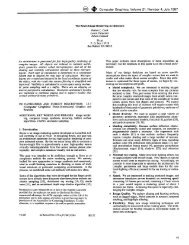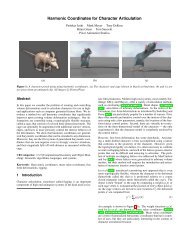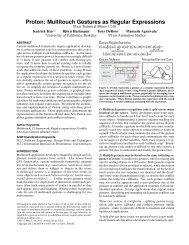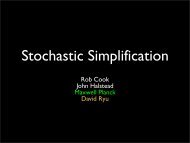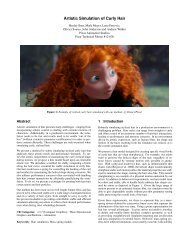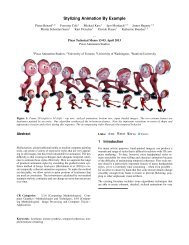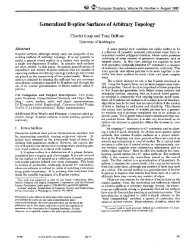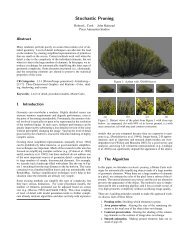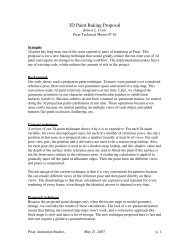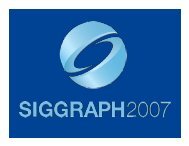Correlated Multi-Jittered Sampling - Pixar Graphics Technologies
Correlated Multi-Jittered Sampling - Pixar Graphics Technologies
Correlated Multi-Jittered Sampling - Pixar Graphics Technologies
Create successful ePaper yourself
Turn your PDF publications into a flip-book with our unique Google optimized e-Paper software.
The cause of the artifacts for Larcher-Pillichshammer is shown in Figure 6;<br />
each sample falls at a regular /N interval along one axis (X in this case). This<br />
property is shared with Hammersley sampling and it is part of what gives them<br />
such low discrepancy. Presumably, adding jitter could help with this, albeit at<br />
the cost of increasing noise. Alternatively, instead of using per-pixel scrambling<br />
to produce a unique pattern at each pixel, some sampling patterns may<br />
be stretched over the entire image and used to produce all of the samples.<br />
This strategy can still alias, however (e.g., using the Halton sequence for image<br />
plane samples with an innite checkerboard plain scene). In general, lowdiscrepancy<br />
QMC sequences trade a higher potential for structured artifacts<br />
against faster convergence.<br />
The convergence rate of these and other sampling patterns in the above<br />
scene is shown in Figure 7. Here, variance is measured as the mean squared<br />
error relative to a reference image computed using 16384 jittered light samples<br />
per pixel. Above 25 samples per pixel, correlated multi-jittering generally outperforms<br />
all other methods except for the Larcher-Pillichshammer sequence.<br />
Figure 6: Larcher-Pillichshammer points. Light<br />
lines are at /N intervals.<br />
M. Pharr and G. Humphreys. Physically Based<br />
Rendering: From Theory To Implementation.<br />
Morgan Kaufmann, 2nd edition, 2010.<br />
10 -3 1 10 100 1000<br />
10 -4<br />
Uniform random<br />
<strong>Jittered</strong><br />
<strong>Multi</strong>-jittered<br />
Sobol's (0,2)<br />
<strong>Correlated</strong> multi-jittered<br />
Larcher-Pillichshammer<br />
10 -5<br />
Variance<br />
10 -6<br />
10 -7<br />
10 -8<br />
Samples per Pixel<br />
Figure 7: Samples per pixel versus variance in the above rectangular light source test scene.<br />
Similar measurements were done on scenes that tested other applications<br />
including the sampling of disk area lights, uniform- and cosine-weighted hemispheres<br />
for BRDFs, image plane positions for antialiasing, and lens positions<br />
for depth of eld. All showed the variance with correlated multi-jittering to<br />
be competitive with Sobol’s (0,2) sequence and occasionally competitive with<br />
the Larcher-Pillichshammer sequence. However, Sobol’s sequence has an advantage<br />
in that it does not require a bound on the number of samples to be<br />
known ahead of time and that it is hierarchical (i.e., the initial points in the<br />
sequence are well distributed) which can simplify progressive rendering.<br />
Table 1 shows the results of our nal evaluation method: for a number<br />
of dierent pattern generation algorithms, an example point set containing<br />
Pattern<br />
Discrepancy<br />
Uniform random .<br />
N-rooks<br />
.<br />
Poisson disk<br />
.<br />
<strong>Jittered</strong><br />
.<br />
<strong>Multi</strong>-jittered<br />
.<br />
Halton<br />
.<br />
Sobol’s (0,2)<br />
.<br />
<strong>Correlated</strong> multi-jittered .<br />
Hammersley<br />
.<br />
Larcher-Pillichshammer .<br />
Table 1: Patterns ordered by decreasing star discrepancy.<br />
4



